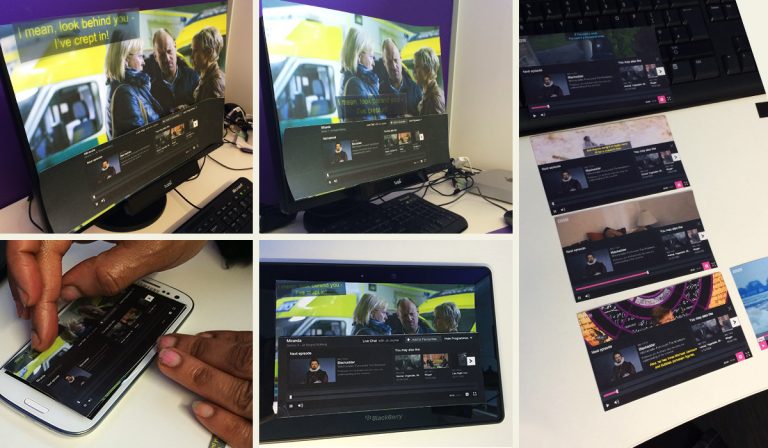
About our client
Since its initial release in 2007, the iPlayer has become an increasing success, bringing television and radio services via the internet to millions of people. This year the BBC have been gradually introducing the Standard Media Player (SMP), a significant improvement over the previous iPlayer versions, across different areas like the iPlayer, News, Sport and others. In early 2014 we contributed to a small, yet important part of the new BBC player, by conducting research into the use of subtitles.
What our client wanted
In order to be successful, the BBC wanted to ensure that the standard media player (code behind the iPlayer) was both accessible and usable for all their viewers.
Bunnyfoot’s task was to help the BBC team understand the best subtitle size and position across different screen sizes and platforms when the ‘More’ panel was expanded. To achieve this objective we conducted qualitative interviews and observation sessions with 24 participants.


What we delivered
- We addressed the research question using a mix of methods: interviewing, paper simulation, observation and ranking exercise
- In order to gauge participants’ ideal subtitle size, we simulated transparency with paper and acetate subtitles, allowing people the freedom to place the subtitles where they wanted
- We used three pre-created variants of the design which allowed us to explore and validate their unprompted placement

Prototype testing on different devices
The work
To complete these objectives we:
- Recruited 24 participants from a diverse range of subtitle user groups including D/deaf, hard-of-hearing, English-as-second-language speakers, dyslexia, Asperger’s, or those who simply preferred to have their subtitles on
- Ran sessions with a British Sign Language (BSL) interpreter who enabled communication between the moderator and the Deaf participants. Being able to talk to BSL speakers directly was one of the most rewarding and unique experiences for us
- Adapted our lab layout and session so that the participants could face both the moderator and the interpreter and made participants more at ease with comforting tea and biscuits
We want to thank Bunnyfoot for the subtitle research. It was really coherent, has generated a lot of interest and provided teams with the start of some solid research from which to start incrementally improving how we deliver subtitles within our Standard Media Player.
Henny Swan
Senior Accessibility Specialist, BBC

The results
- We learned that the BBC was seen by many participants as a leader “across the board” in terms of quality and quantity of subtitles
- Surprisingly, fewer participants reported using subtitles online due to smaller screen size, ability to use their headphones, not knowing or not expecting this functionality to be available
- Participants were aware of automated tools and non-professional subtitle creation online and generally experienced a lower quality online than on their TV. Their expectation was that all platforms should have the same level of service
- Our work uncovered a fascinating range of reasons as to why people used subtitles, including:
- “When I’m putting the little one to sleep.“
- “My 6-year-old likes to read everything.“
- “I grew up with subtitles as my dad is deaf.“
- “To give my ears a rest!“
- The paper exercise, the observation and the ranking exercise concluded that participants preferred the subtitles to jump to the top when the ‘More’ panel was expanded
Our research was a small piece of the puzzle within the complex process of providing subtitle services – some of it included in the BBC’s SMP accessibility improvements, with some of it remaining in the teams’ behind-the-scenes work.

Contact us to see how we can help
Please complete the following form, alternatively, you can email us. For jobs and work experience opportunities, please visit our jobs page.
Office hours
We are available weekdays, 9am to 5:30pm.
We aim to respond to all messages within 24 hours, if sent within our office hours.






